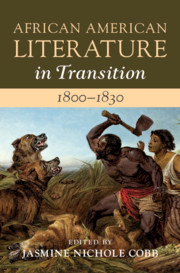Book contents
- African American Literature in Transition, 1800–1830
- African American Literature in Transition
- African American Literature in Transition, 1800–1830
- Copyright page
- Contents
- Figures
- Contributors
- Preface
- Chronology
- Introduction
- Part I Black Organizational Life before 1830
- Part II Movement and Mobility in African American Literature
- Part III Print Culture in Circulation
- Part IV Illustration and the Narrative Form
- Index
Part IV - Illustration and the Narrative Form
Published online by Cambridge University Press: 11 March 2021
- African American Literature in Transition, 1800–1830
- African American Literature in Transition
- African American Literature in Transition, 1800–1830
- Copyright page
- Contents
- Figures
- Contributors
- Preface
- Chronology
- Introduction
- Part I Black Organizational Life before 1830
- Part II Movement and Mobility in African American Literature
- Part III Print Culture in Circulation
- Part IV Illustration and the Narrative Form
- Index
Summary
Chapters in the fourth and final section, “Illustration and the Narrative Form,” explore transitions in visual culture of the early nineteenth century. By 1830, there was a growing diversity of Black portrayals in visual culture, ranging from the well-meaning but often misguided antislavery imagery to the purposefully hostile proliferation of anti-Black caricature. In materials that circulated privately, such as the friendship albums passed among free Black women, illustrations appeared alongside writing as hand-painted flowers denoted sentimental notes and poems.1 Similarly, southern newspapers printing runaway advertisements for fugitive free Blacks hailed readers with the iconic stereotype of a runaway man or woman, on the move with stolen property. In addition to images, social activity also wielded an impact on visual culture. For instance, the 1808 ban on new importations of slaves from Africa was clear and present in the minds of African Americans. Not only did they mark these occasions with sermons and pamphlets produced to discuss these events, but also their freedom celebrations – public ceremonies and parades in Boston’s free Black community, for example – were meant to take up space in public with visual demonstrations about abolition’s significations.2
- Type
- Chapter
- Information
- African American Literature in Transition, 1800–1830 , pp. 255 - 343Publisher: Cambridge University PressPrint publication year: 2021

